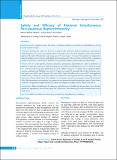Please use this identifier to cite or link to this item:
https://hdl.handle.net/20.500.14356/1446Full metadata record
| DC Field | Value | Language |
|---|---|---|
| dc.contributor.author | Adhikari, Mahesh Bahadur | - |
| dc.contributor.author | Karna, Sumeet | - |
| dc.contributor.author | Kasaju, Atul | - |
| dc.date.accessioned | 2023-05-11T08:15:16Z | - |
| dc.date.available | 2023-05-11T08:15:16Z | - |
| dc.date.issued | 2019 | - |
| dc.identifier.citation | AdhikariM. B., KarnaS., & KasajuA. (2019). Safety and Efficacy of Bilateral Simultaneous Percutaneous Nephrolithotomy. Journal of Nepal Health Research Council, 17(01), 114-118. https://doi.org/10.33314/jnhrc.v17i01.1357 | en_US |
| dc.identifier.issn | Print ISSN: 1727-5482; Online ISSN: 1999-6217 | - |
| dc.identifier.uri | http://103.69.126.140:8080/handle/20.500.14356/1446 | - |
| dc.description | Original Article | en_US |
| dc.description.abstract | Abstract Background: To evaluate the safety and efficacy of bilateral simultaneous percutaneous nephrolithotomy in one tertiary hospital in Nepal. Methods: Retrospective study was done for all patients that underwent bilateral simultaneous percutaneous nephrolithotomy in our center from January 2010 to December 2017. The study included 36 male and 16 female patients with totalof 104renal units at an average age of 37 years (range 3 -65 years). Five patients were planned for bilateral simultaneous Percutaneous nephrolithotomy, but intraoperatively the procedure was aborted after completion of only one side due to various factors. All PCNL were performed in prone position under general anesthesia. Results: In91.2% of the patients, bilateral simultaneous percutaneous nephrolithotomy could be performed as planned. Average time required for bilateral simultaneous percutaneous nephrolithotomy was 94 ± 38.8mins (range 25 – 170 mins) with average hemoglobin drop of 1.85 ± 1.30gm% (range 0.1 - 4.2gm%) and no significant change in serum creatinine levels. Multiple access tracts (>1) had to be created in 3 renal units. Most of the renal stones were Guy’s stone score (GSS) 1 and 2 whereas 15.4% were GSS of 3 and 4.Overall stone free rate was 94% with significant residual stones (>4mm) in 6 renal units which were subjected to extracorporeal shockwave lithotripsy (SWL) on a later date (Clavien-Dindo Grade: III-a). Bladder clot evacuation was done in one patient (Clavien-Dindo Grade: III-b). Blood transfusion was required in two patients and two patients developed postoperative sepsis (Clavien-Dindo Grade: II). One patient developed hydrothorax which was managed successfully (Clavien-Dindo Grade: III-a). Conclusions: Bilateral simultaneous Percutaneous nephrolithotomy is feasible and safe procedure, given that the patients are appropriately selected based upon Guy’s stone score, stone burden, pelvi-calyceal anatomy and overall health status. Keywords: Bilateral simultaneous;endourology; percutaneous nephrolithotomy; urolithiasis. | en_US |
| dc.language.iso | en | en_US |
| dc.publisher | Nepal Health Research Council | en_US |
| dc.relation.ispartofseries | Jan-March, 2019;1357 | - |
| dc.subject | Bilateral simultaneous;endourology | en_US |
| dc.subject | Percutaneous nephrolithotomy | en_US |
| dc.subject | Urolithiasis | en_US |
| dc.title | Safety and Efficacy of Bilateral Simultaneous Percutaneous Nephrolithotomy | en_US |
| dc.type | Journal Article | en_US |
| local.journal.category | Original Article | - |
| Appears in Collections: | Vol. 17 No. 1 Issue 42 Jan - Mar 2019 | |
Files in This Item:
| File | Description | Size | Format | |
|---|---|---|---|---|
| 1357-Manuscript-9282-1-10-20190429.pdf | Fulltext Download | 232.64 kB | Adobe PDF |  View/Open |
Items in DSpace are protected by copyright, with all rights reserved, unless otherwise indicated.
